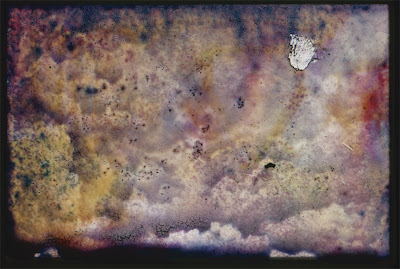
"When the curator John Pohl was a teenager building props and sets for the Guthrie Theater in Minneapolis, he also became obsessed with a very unlikely “storyboard”—the
Codex Zouche-Nuttall, a fifteenth-century manuscript in the southern Mexican Mixtec pictographic language that was still in use at the time of the Spanish conquest. One of a handful of pre-Columbian codices to survive the book-burning policies of the Catholic Church, the
Codex Nuttall is a remarkable thirty-foot-long, double-sided deer hide accordion scroll covered with intricate, beautiful paintings that tell the adventures of the eleventh-century Oaxaca warrior-king, Lord Eight Deer Jaguar-Claw. Unlike the then-lost Classic Mayan script, which used syllabic glyphs to represent the phonetics of spoken language, Mixtec is almost entirely pictorial, resulting in a relatively intelligible graphic narrative.


Moving to Los Angeles in the early seventies, Pohl embarked on a unique interdisciplinary education combining archaeology and animation. “I saw it,” he recalls “as the basis for an ideal collaboration between the ancient painter and the contemporary filmmaker. The more I learned about animation, the more I began to detect certain principles in form and design that matched the composition of painted books utilized by the pre-Columbian Mexican civilizations. The emphasis on shortened bodies with enlarged heads and hands, once dismissed by art historians as primitive in design, were exactly what made the earliest Disney characters so effective at communicating basic human emotions cross-culturally, and from longer distances, which made it perfect for courtly settings. So, I started animating these things from the
Dover facsimile publication back in the seventies.”

From this idiosyncratic starting point, Pohl has gone on to become one of the most respected scholars of the Postclassic period of Mesoamerican history, the era between the still mysterious collapse of the Classic Mayan empire around 900 CE and the rise to power of the Aztecs and the arrival of the Spanish in the 1500s. But the
Codex Nuttall has remained a central obsession. “Unlike many of my colleagues, who were deciphering Mayan writing, I was more interested in why people don’t write. So, I became a specialist in this late Postclassic system, and I’ve spent the thirty-five years of my career not only deciphering this, but actually going out and finding the actual places.”


Pohl’s Nuttall obsession reached a pinnacle recently, when the British Museum agreed to lend the precious manuscript for the first time, as the pivotal artifact in
Children of the Plumed Serpent: The Legacy of Quetzalcoatl in Ancient Mexico—an extraordinary exhibit cocurated by Pohl with Victoria Lyall and the late Virginia Fields of the Los Angeles County Museum of Art, where it debuted in April before traveling to the Dallas Museum of Art in July.


What loosened the Brits’ grip was the specificity of
Children of the Plumed Serpent, which was organized, in part, as an alternative to the many surveys of pre-Columbian art and culture that focus on Classic Mayan or conquest-era Aztec periods, ignoring the six centuries in between. During that period, a visually rich but much less centralized culture flourished around the unifying legendary figure of Quetzalcoatl.


Quetzalcoatl is the feathered serpent god who, in human form, was said to have been the king of Tula, a real city north of Mexico City, which—also known as Tollan—served as a sort of Eden in Postclassic mythology. After a rival deity gets him drunk and he commits incest with his sister, Quetzalcoatl is banished and wanders through southern Mexico, where he spreads innovative agricultural and artistic technologies and becomes the patron of many small, independent Nahua, Mixtec, and Zapotec kingdoms in the region in and around modern Oaxaca..."
Read the rest of Artists Rule here.
Images: Feathered Serpent with the Year 1 Reed AD 1200-1521, Mexico Basalt 8 1⁄4 x 17 5/16 in.; Codex Nuttall 15th–16th century, Mexico, Western Oaxaca Deerskin gesso and pigments, 44 11/16 x 7 1/2 x 9 1/4 in.; Codex Selden AD 1556-1560, Mexico, Western Oaxaca Deerskin, gesso and pigments 20 leaves, 10 7/8 x 10 7/8 in.; Relación Geográfica Map of Teozacoalco AD 1580 Mexico, Oaxaca, 56 x 69 11/16 in!; Turquoise-mosaic Disk AD 1300-1521, Mexico Turquoise and wood, 15 3/8 in. (diam.); Turquoise-mosaic Disk AD 900-1200, Mexico, Yucatán, Chichén Itzá Wood and turquoise, 9 5/8 x 3⁄4 in. (diam.); Solar Disk AD 1530-1650, Mexico, Puebla, Tepeaca Stone, 9 1/16 x 43 5/16 in.; Skull with Turquoise Mosaic 1400-1521, Mexico, Western Oaxaca or Puebla Human skull with turquoise, jadeite and shell, 6 1⁄2 x 6 x 8 in.; Turquoise-mosaic Shield AD 1100-1521, Mexico, Puebla, Acatlan Wood, stone, tree resin, and turquoise, 12 13/16 x 12 3/4 x 13/16 in.; Turquoise-mosaic Disk AD 900-1200, Mexico, Hidalgo, Tula Turquoise, pyrite and wood, 13 5/16 x 7/8 in. (diam.)























